Belly landing
A belly landing or gear-up landing occurs when an aircraft lands without its landing gear fully extended and uses its underside, or belly, as its primary landing device. Normally the term gear-up landing refers to incidents in which the pilot forgets to extend the landing gear, while belly landing refers to incidents where a mechanical malfunction prevents the pilot from extending the landing gear.
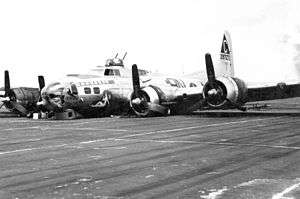
During a belly landing, there is normally extensive damage to the airplane. Belly landings carry the risk that the aircraft may flip over, disintegrate, or catch fire if it lands too fast or too hard. Extreme precision is needed to ensure that the plane lands as straight and level as possible while maintaining enough airspeed to maintain control. Strong crosswinds, low visibility, damage to the airplane, or unresponsive instruments or controls greatly increase the danger of performing a belly landing. Still, belly landings are one of the most common types of aircraft accidents, and are normally not fatal if executed carefully.
Causes and prevention
Pilot error
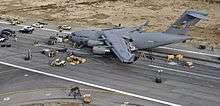
The most common cause of gear-up landings is the pilot simply forgetting to extend the landing gear before touchdown. On any retractable gear aircraft, lowering the landing gear is part of the pilot's landing checklist, which also includes items such as setting the flaps, propeller and mixture controls for landing. Pilots who ritually perform such checklists before landing are less likely to land gear-up. However, some pilots neglect these checklists and perform the tasks by memory, increasing the chances of forgetting to lower the landing gear. Even careful pilots are at risk, because they may be distracted and forget to perform the checklist or be interrupted in the middle of it by other duties such as collision avoidance or another emergency. In the picture shown above, the B-17 Dutchess' Daughter had landed normally, when the copilot inadvertently flipped the landing gear switch to retract. The gear collapsed near the end of the landing roll.[3]
All aircraft with retractable landing gear are required to have a way to indicate the status of the landing gear, which is normally a set of lights that change colors from red to amber to green depending on whether the gear are up, in transit, or down. However, a distracted pilot may forget to look at these lights. This has led to aircraft designers building extra safety systems in the aircraft to reduce the possibility of human error. In small aircraft this most commonly takes the form of a warning light and horn which operate when any of the landing gear is not locked down and any of the engine throttles are retarded below a cruise power setting. However, the horn has been useless in situations when the pilot was unfamiliar with the aircraft and did not know what the horn sounding was meant to indicate. Pilots have sometimes confused the landing gear warning horn with the stall warning horn. In other cases, pilots cannot hear the horn on older aircraft due to wearing a modern noise-canceling headset.
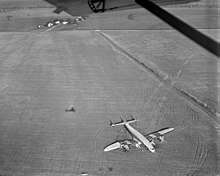
In larger aircraft, the warning system usually excludes the engine power setting and instead warns the pilot when the flaps are set for landing but the landing gear is not. An alternative system uses the ground proximity warning system or radar altimeter to engage a warning when the airplane is close to the ground and descending with the gear not down. Most airliners incorporate a voice message system which eliminates the ambiguity of a horn or buzzer and instead gives the pilot a clear verbal indication: "GEAR NOT DOWN". In addition, large aircraft are designed to be operated by two pilots working as a team. One flies the aircraft and handles communications and collision avoidance, while the other operates the aircraft systems. This provides a sort of human redundancy which reduces the workload placed on any one crew member, and provides for one crew member to be able to check the work of the other. The combination of advanced warning systems and effective crew training has made gear-up landing accidents in large aircraft extremely rare.
In some cases, the pilot may be warned of an unsafe gear condition by the aircraft's flying characteristics. Often very sleek, high-performance airplanes will be very difficult to slow to a safe landing speed without the aerodynamic drag of the extended landing gear.
Mechanical failure
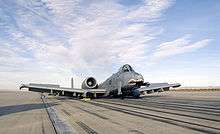
Mechanical failure is another cause of belly landings. Most landing gear are operated by electric motors or hydraulic actuators. Multiple redundancies are usually provided to prevent a single failure from failing the entire landing gear extension process. Whether electrically or hydraulically operated, the landing gear can usually be powered from multiple sources. In case the power system fails, an emergency extension system is always available. This may take the form of a manually operated crank or pump, or a mechanical free-fall mechanism which disengages the uplocks and allows the landing gear to fall and lock due to gravity and/or airflow.
In cases where only one landing gear leg fails to extend, the pilot may choose to retract all the gear and perform a belly landing because he or she may believe it to be easier to control the aircraft during rollout with no gear at all than with one gear missing.
Some aircraft, like the A-10 Thunderbolt II, are specifically designed to make belly landings safer. In the A-10's case, the retracted main wheels protrude out of their nacelles, so the plane virtually rolls on belly landings.
Unmanned belly landings
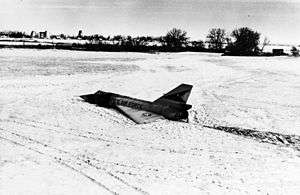
There are examples of aircraft making comparatively successful belly landings after being abandoned by their crew in flight.
A German Junkers 88 bomber which, after an attack on Soviet shipping in April 1942, was abandoned by its crew and came down on a hillside at Garddevarre in Finnmark in the far north of Norway. It was recovered in 1988 and is currently displayed at the Norsk Luftfartsmuseum, the Norwegian Aviation Museum at Bodø Airport.[4]
On 27 September 1956 a Bell X-2 experimental aircraft, after establishing an airspeed record of Mach 3.2, landed unmanned in the desert after a series of stalls and glides. It was only superficially damaged. The pilot had used his escape system at about 40,000 ft after losing control of the aircraft. He was killed when his capsule hit the desert.[5]
Possibly the most well-known is a United States Airforce Convair F-106 Delta Dart, tail number 58-0787. In February 1970, the aircraft entered a flat spin over Montana. Following the pilot ejecting, the aircraft's spin stabilised, and the Delta Dart proceeded to fly for several miles until it came down in a field near Big Sandy, Montana. The aircraft (later nicknamed the Cornfield Bomber) was repaired and returned to service. After the F-106 was withdrawn from service, the aircraft was presented to the National Museum of the United States Air Force.[6]
Examples
On 4 July 2000, Malév Flight 262, a Tupolev Tu-154, accidentally performed a gear-up touchdown during the landing and skidded on the runway, but was able to take off and land normally after a go-around. No injuries were reported.[7][8]
On 8 May 2006, a United States Air Force B-1 Lancer strategic bomber landed on the atoll of Diego Garcia in the Indian Ocean without lowering its undercarriage.[9] A fire ensued, but was extinguished with only minor personnel injuries. The pilots had reportedly switched off the warning system that would have warned them of the oversight and overlooked the red warning light on the instrument panel throughout the landing. The aircraft, after nearly $8 million in repairs, was returned to service the following year.
On 1 November 2011, LOT Polish Airlines Flight 016, a Boeing 767, Captain Tadeusz Wrona declared an emergency with a loss of landing gear en route from Newark Liberty International Airport to Warsaw Chopin Airport. The aircraft involved was the newest 767 airframe in the fleet. It made a belly landing (see video) in Warsaw with a small fire, but all passengers and crew were evacuated with no injuries. The airport was closed for over a day afterwards.[10]
References
- Cenciotti, David (8 May 2009). "C-17 gear up landing: investigation results". The aviationist. Retrieved 16 August 2014.
- "Aircraft Accident Investigation Board Report." Archived 16 October 2012 at the Wayback Machine USAF Aircraft Accident Investigation Board, 5 May 2009. Retrieved: 3 September 2010.
- http://www.303rdbg.com/missionreports/197.pdf - 303rd Bomb Group, 8th Air Force, mission 197 report, 6 July 1944
- Sørensen, Kjell. "Junkers Ju 88 A-4 Garddevarre Finnmark." Archived 1 September 2012 at the Wayback Machine flyvrak - World War II Aircraft wreck sites in Norway & other countries. Retrieved: 11 September 2012.
- https://www.nasa.gov/centers/dryden/pdf/88484main_H-2106.pdf, p.15
- "Fact Sheets – Convair F-106A Delta Dart". National Museum of the United States Air Force. Archived from the original on 14 September 2011. Retrieved 27 July 2011.
- Accident description at the Aviation Safety Network
- Zhirnihin, Sergey (8 August 2002). "Crew is responsible for landing accident of the Tu-154 owned by Hungarian MALEV airline" (in Russian). RIAN. Retrieved 2 June 2008.
- "Report: pilot error caused B-1B crash." Archived 9 August 2012 at the Wayback Machine Air Combat Command Public Affairs, USAF, 18 September 2006. Retrieved: 27 May 2012.
- "LOT belly landing in Warsaw". Archived from the original on 15 April 2012. Retrieved 1 November 2011.